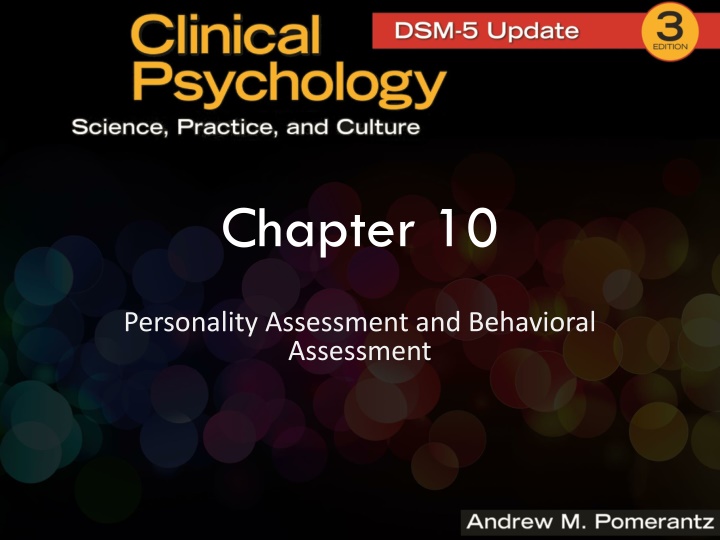
Personality Assessment Methods
Discover the importance of using multiple methods, evidence-based approaches, and culturally competent assessments in evaluating personality and behavior. Learn about objective personality tests like the MMPI-2 and their significance in psychological evaluation.
Download Presentation

Please find below an Image/Link to download the presentation.
The content on the website is provided AS IS for your information and personal use only. It may not be sold, licensed, or shared on other websites without obtaining consent from the author. If you encounter any issues during the download, it is possible that the publisher has removed the file from their server.
You are allowed to download the files provided on this website for personal or commercial use, subject to the condition that they are used lawfully. All files are the property of their respective owners.
The content on the website is provided AS IS for your information and personal use only. It may not be sold, licensed, or shared on other websites without obtaining consent from the author.
E N D
Presentation Transcript
Chapter 10 Personality Assessment and Behavioral Assessment
Multimethod Assessment No measure of personality or behavior is perfect It is best to use multiple methods Tests Interviews Observations Other sources Convergent conclusions can be made with more confidence
Evidence-Based Assessment Assessment based on what works empirically Similar to movement regarding what works in therapy, but data is not quite as abundant yet Typically tied to particular disorders Ex. SCID and BDI-II for assessing depression
Culturally Competent Assessment Every culture has its own definitions of normal and abnormal Culturally competent clinical psychologists are aware of this, and of the influence of their own cultural perspective Especially important not to overpathologize View as abnormal what is culturally normal
Objective Personality Tests Include unambiguous test items, offer clients a limited range of responses, and are objectively scored Typically self-report questionnaires Typically a series of brief statements or questions to which clients respond in a true/false or multiple choice format
Minnesota Multiphasic Personality Inventory- 2 (MMPI-2) Most popular and most psychometrically sound objective personality test Used worldwide; translated into dozens of languages Pencil & paper format 567 self-descriptive sentences Client marks true or false for each
Minnesota Multiphasic Personality Inventory- 2 (MMPI-2) (cont.) Original MMPI was published in 1943 Primary authors were Starke Hathaway and J. C. McKinley Empirical criterion keying was used as test construction method Revised edition, MMPI-2, was published in 1989 Better norms Less outdated wording of items
Minnesota Multiphasic Personality Inventory- 2 (MMPI-2) (cont.) MMPI and MMPI-2 feature 10 clinical scales 1 Hypochondriasis 2 Depression 3 Hysteria 4 Psychopathic Deviate 5 Masculinity/femininity 6 Paranoia 7 Psychasthenia 8 Schizophrenia 9 Mania 0 Social Introversion Also feature supplemental scales and content scales for additional clinical information
Minnesota Multiphasic Personality Inventory- 2 (MMPI-2) (cont.) MMPI and MMPI-2 also feature validity scales To measure test-taking attitudes Can identify clients who fake good or fake bad, or clients who respond randomly MMPI-A (for adolescents, age 14-18) was published in 1992 Similar clinical scales, validity scales, and administration MMPI-2-RF most recent edition briefer, less overlap between clinical scales
Minnesota Multiphasic Personality Inventory- 2 (MMPI-2) (cont.) Strengths include psychometrics (established reliability and validity) and comprehensiveness Limitations include length, reading requirement, attention requirement, and emphasis on pathology/abnormality
Minnesota Multiphasic Personality Inventory- 2 (MMPI-2) (cont.) Therapeutic Assessment Interesting use of MMPI-2, developed by Stephen Finn and colleagues MMPI-2 feedback used as a brief therapeutic intervention What psychologists intend as assessment clients can experience as therapeutic
Millon Clinical Multiaxial Inventory (MCMI-III) Originally created by Theodore Millon Like the MMPI-2 in some ways Comprehensive objective personality test Self-report, pencil & paper format Main difference: MCMI-III emphasizes personality disorders Its clinical scales are based on DSM personality disorders (e.g., antisocial, borderline, narcissistic, paranoid)
NEO Personality InventoryRevised (NEO- PI-R) Originally created by Paul Costa and Robert McCrae Another objective personality test Pencil & paper, self-report format Main distinction: measures normal personality traits (not pathologies) Based on Five Factor model of personality Neuroticism, Extraversion, Openness, Conscientiousness, Agreeableness Lacks validity scales, and of limited help with clinical diagnosis
California Psychological Inventory-III (CPI-III) Another objective personality test Pencil & paper, self-report Like NEO-PI-R, doesn t emphasize pathology Emphasizes positive attributes of personality strengths, assets, internal resources Consistent with recent positive psychology movement Also goes by name CPI-434 (434 items)
Beck Depression Inventory-II (BDI-II) Not a comprehensive test of personality, but a brief, targeted measure of one characteristic (depression symptoms) 21 items; takes 5-10 minutes to complete Pencil & paper, self-report format Lacks validity scales, and much more limited scope than other tests discussed to this point
Projective Personality Tests Based on the assumption that clients will project their personalities when presented with unstructured, ambiguous stimuli and an unrestricted opportunity to respond Lack of objectivity in scoring and interpretation Considered by many to be empirically inferior to objective tests Usage has declined in recent decades Advocates claim they are less fake-able
Rorschach Inkblot Method Created in 1921 by Hermann Rorschach 10 inkblots (5 in color, 5 black & white) are presented Clients say what they see in each blot (in response phase) Later (in inquiry phase), explain what features of the blot caused them to make their responses Exner s Comprehensive System is most widely used scoring system
Rorschach Inkblot Method (cont.) Scoring emphasizes how the client perceives the blot as well as what the client sees Scoring variables include: Location (Whole blot, large part, or small detail?) Determinants (Form, color, or shading of blot?) Form Quality (Conventional? Distorted?) Popular (What others see? Idiosyncratic?) Content (What kinds of objects appear frequently?) Reliability and validity are questionable and hotly debated
Thematic Apperception Test (TAT) Published in 1943 by Henry Murray and Christiana Morgan Like Rorschach in that it involves a series of cards with ambiguous stimuli Cards feature interpersonal scenes rather than inkblots Client tells a story to go along with each scene Often, not formally or empirically scored Reliability and validity are questionable
Tell-Me-a-Story (TEMAS) Recent TAT-style apperception test Greater emphasis on cultural sensitivity (via portrayal of diverse individuals in cards) Greater emphasis on empirical scoring via normative data
Sentence Completion Tests The ambiguous stimuli are not inkblots or interpersonal scenes, but beginnings of sentences Rotter Incomplete Sentence Blank (RISB) is most widely used Simulated examples: I enjoy_______________. It makes me furious_______________. My greatest weakness_________. Not often formally or empirically scored Reliability and validity are questionable
Behavioral Assessment Assumes that client behaviors are not signs of underlying issues or problems; instead, those behaviors are the problems The behavior a client demonstrates is a sample of the problem itself, not a sign of some deeper, underlying problem
Techniques of Behavioral Assessment Behavioral observation is the most essential technique Direct, systematic observation of a client s behavior in the natural environment Also known as naturalistic observation Requires operationally defining target behavior and measuring its frequency, duration, or intensity across specified time periods Often more accurate than asking client to report on their own behaviors
Techniques of Behavioral Assessment (cont.) When naturalistic observation is not possible, analogue observation is used Replicate situation in clinic Recording of behaviors is crucial Done by parent, teacher, friend, or client Enables functionality of behavior to be determined This functionality is key concept in behavioral assessment
Technology in Behavioral Assessment Laptop computers or handheld devices can be used to record observed behaviors Numerous software programs have been created for this purpose Clients can use similar technological tools for self-monitoring






















